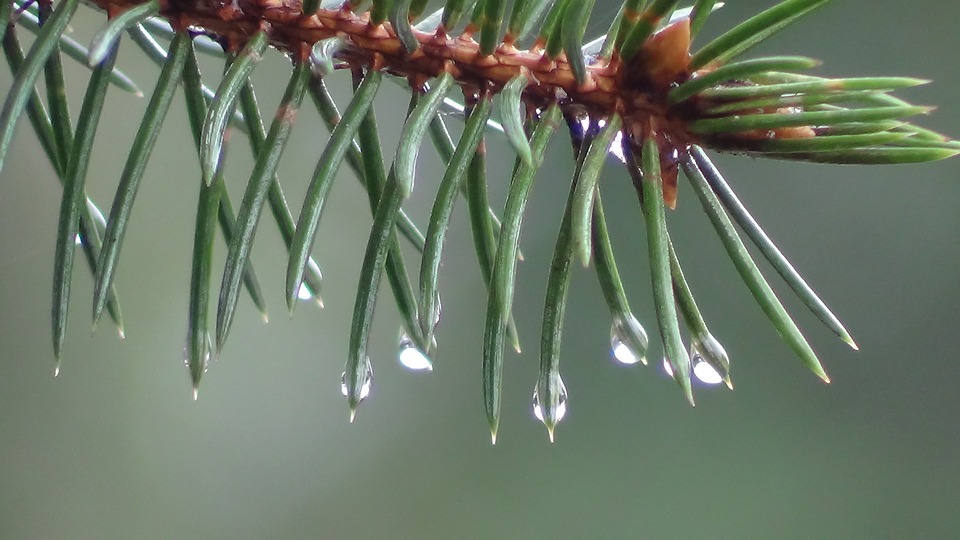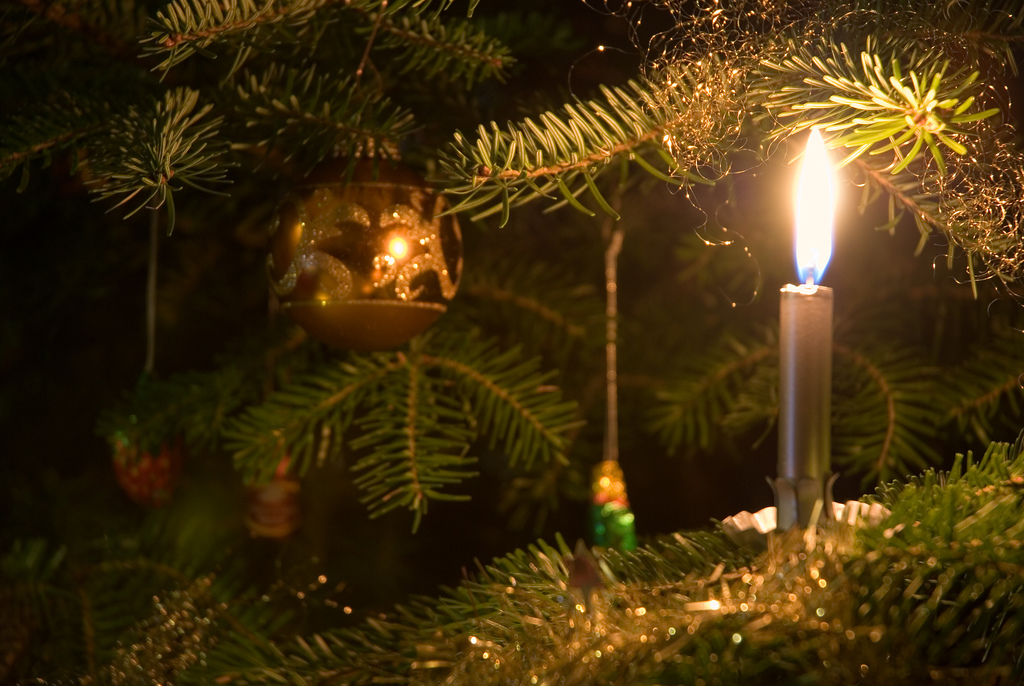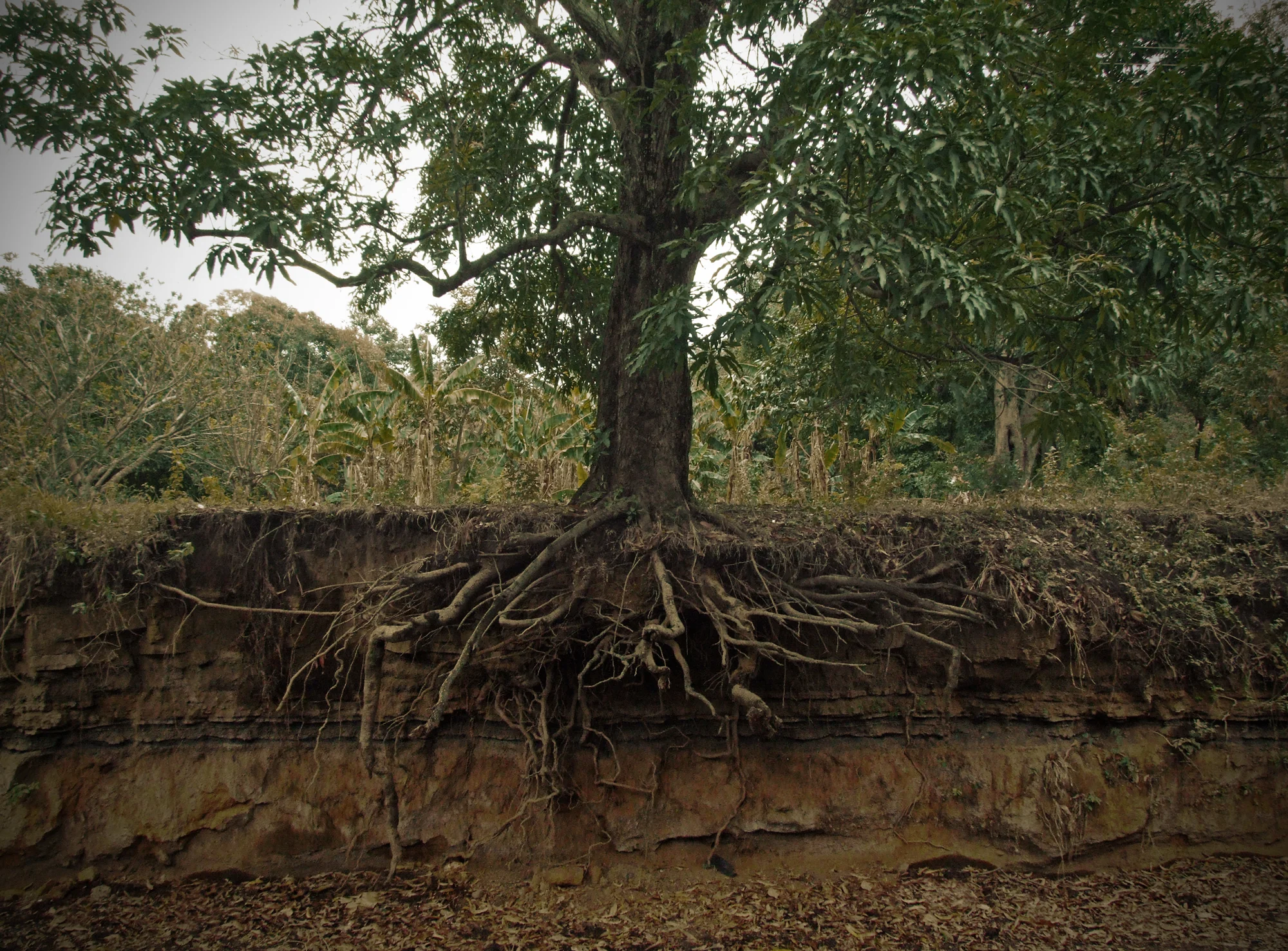So now that we’ve sprinted through approximately 480 million years of evolution, going from Charophyte algae to bryophyte moss to primitive vascular Cooksonia to the first forests it’s time stop, breathe, and look around at the plants in our lives.
Walk into your living room or den. Chances are, given the season and proximity of a certain, winter holiday, that you have a tree set up in your house. As lovely as the tree might look with all the ornaments, ribbons and lights I want you, for a moment, to look beyond that, to the tree before it was decorated. What do you see?
You probably see something like this.
The first thing you probably see are the needles of your Christmas tree. They’re hard to miss, green all year and, depending on the species, sharp to the touch. The needles are actually the leaves of your Christmas tree.
This bird is shocked that pine needles are leaves. Photo by john henderson/iStock / Getty Images
Yep. Pine, fir, spruce and other conifer needles are actually complex, photosynthetic organs, just like the leaves you're used to seeing on other plants. Don't believe me? Let's take a close look at leaf anatomy, closer than you can see with the naked eye. Leaves are specialized photosynthetic organs. They have a large surface area to maximize sunlight exposure. They are thin enough to allow light to penetrate through the leaf to the cells on the bottom.
The upper leaf, surface (epidermis) of the leaf is covered in a waxy material called the cuticle, to prevent water loss and gas exchange. Underneath the epidermis is a layer of tightly-packed, rod-shaped, "Palisade parenchyma cells". These cells have tons of chloroplasts and are the most photosynthetically active of the cells of the leaf. Under the palisade layer are "spongy parenchyma" cells which facilitate gas exchange with loose structure. They also surround vascular tissue. The lower epidermis has a thin cuticle and pores that house stoma cells that control gas exchange, the "plant breathing" of oxygen and water vapor release. Now I know what you're thinking. Pine needles aren't like that at all.
A pair of thin-slices of pine needle under a microscope, stained with dye for contrast. (source)
Look closely. You can see a central vessel carrying xylem and phloem surrounded by thin, spongy parenchyma. You can see thick layers of palisade parenchyma (in deep red). There's a thick cuticle around the outside and deep pores for stomata. All the essential leaf structures wrapped up like sushi. Pine trees grow leaves like these to maximize water retention and the longevity of the leaves so they can photosynthesize year-round in cold, dry or harsh conditions.
Now take a look at the ends of of one of the branches. If necessary pull aside ornaments or other festooning implements. You should see a bud at the very end, possibly flanked by additional buds, depending on the species of tree.
Those buds at the ends of your branches are actually stem cells. Buds at the ends of branches and at the tops of trees are called meristems. These give rise to the organs of the plant, the leaves, the bark, the vascular tissue and to the roots (each root tip is made of meristem tissue). The meristem buds you see at the ends of the branches help control how the branch grows. They are, in turn, regulated by the apical meristem at the top of the tree. The meristem at the top is said to be "dominant" and prevents other apical meristems from growing. It's what gives your pine tree a distinct, single trunk and gradually sloping branch structure. It also means that the trunk grows upward faster than the branches can grow sideways. Other than the root meristem there's one other meristem that you can't see. The cambium.
A cross-section of a tree trunk. Note the two cambria. (Source)
See the vascular cambium there? Those are meristematic stem cells too. They produce two types of tissue. Xylem on the interior of the tree and phloem on the exterior. Xylem is the dead, woody, water-transporting tissue. Phloem is living tissue that transports sap and plant products. There's a second layer of cambium on the outside of the vascular cambium, the cork cambium. This sole living layer of bark and gives rise to bark tissue. If you scratch the trunk of your Christmas tree you can see the cambium as a green layer just under the bark (that is if you can get past the sharp needles and strings of lights).
Cross section of a mature, woody tree (Source)
Keep scratching and you can see the sapwood, the layer of wood that still moves up the trunk. Inside the sapwood is the heartwood which is so clogged with resin and tannins that it can't conduct water (incidentally tannins and resin prevent the heartwood from decaying and repel certain insects). Heartwood serves as structural support for the tree and lets it grow tall. If you can see the heartwood that probably means you're looking at a cross-cut of the tree and can see growth rings. The dark rings are denser and grow in the winter while the light sections are less dense and are laid down during the summer growing season. Tropical trees don't produce rings because the differences between the dry and wet season aren't distinct enough to produce visible rings. On a pine tree you'll also see "rays" radiating outward from the center of the tree. These conduct resin through the tree.
We at Our City Forest recommend waiting to take the decorations off your tree to look at the heartwood. (Source)
That's where the story stops for those of you who have a real, cut tree. If you're one of the many, happy recipients of one of our Holiday Rent A Trees you still have one more thing to explore, the root system.
The root system is like the unseen part of an iceberg. It extends deeper and wider than the visible portion of the tree.
Roots are actually the first organ to emerge from a seed and have their own meristems. In trees, a central, taproot extends first. Root tissue, like leaf tissue, is able to sense light, moisture and the direction of gravity so it can grow in the correct direction. The meristem grows downward leaving behind differentiated tissues, epidermis, parenchyma, endodermis, pericycle, procambium, phloem and xylem (presented here in order from outermost to innermost). The procambium and pericycle are both meristems like the cambium of the trunk. The pericycle makes parenchyma cells and lateral roots while the procambium produces vascular tissue. The vascular tissue is continuous with the vascular tissue of the trunk. and leaves, letting water and photosynthetic products flow through the tree.
A cross section of a mature tree root. Thanks Wikipedia!
But what does all this stuff do? Well you already know that xylem carries water and phloem carries plant products. You also know that the procambium and pericycle are meristems and therefore are plant stem cells that direct and control plant growth in response to plant hormones. The epidermis isn't like the leaf cuticle or cork, it's permeable to let water in and is covered in fine root hairs to grab water and nutrients. The parenchyma is one part storage one part transportation system. The endodermis is semipermeable and prevents things the tree doesn't like from getting inside the vasculature while letting water and other goodies in. As the root gets larger the pericycle may start to produce cork periderm to protect the large roots closest to the trunk. This guards the root system from herbivorous attack, breakage and water loss.
The buttress roots of a Ficus macrophylla tree in Paloma. Roots can get seriously large. (Source)
Roots don't just serve a nutrient and support function. Remember that meristems control the plant's growth and direct the plant toward resources. Roots might also be responsible for a previously undescribed type of cognition. Roots also do some other cool things like partner with bacteria and fungi to provide essential nutrients and nitrogen to plants. Some roots are reproductive and allow trees to clone themselves. If you've ever seen a quaking aspen stand you're actually looking at a colony of interconnected clones. Banyan trees can also do some remarkable things with giant, aerial roots. To a casual observer these roots are indistinguishable from tree trunks.
Wikipedia once again provides an appropriate image. "Big Banyan Tree at Bangalore" by Kiran Gopi
Some of you, I'm sure, are hopping up and down right now screaming FRAUD! FRAUD! Trickster! Deceiver! I looked up and down at my Christmas tree and it's nothing like the tree you described. I even cut the thing in half and there weren't rings! It's ok. I anticipated that because...
You probably decorated a palm tree... (source)
As it turns out, palm trees aren't true trees (and yes some people use them as Christmas trees). Like lots of things with common names palm trees aren't actually what they appear to be, sorta like how European and American robins aren't the same bird. Want to find out what a palm tree actually is? Join me next time on Everything You Wanted To know About Plants.














